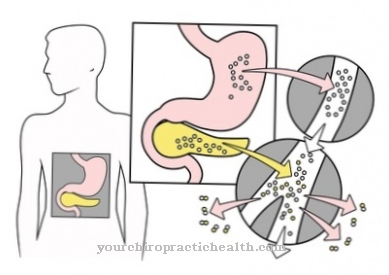During embryogenesis, during which the child grows in the womb, the brain's dispositions are also formed and differentiated. It is from the Brain development the speech. This continues even after the birth. If disturbances in brain development occur, this can lead to serious problems.
What is brain development?

The development of the brain can be roughly divided into embryonic and postnatal brain development. During the embryonic period, the tissue structures of the nervous system develop through processes of cell differentiation and specialization. Newborns have developed tissues that make up the brain and nervous system.
Brain development continues after birth. With 100 billion neurons in the brain, newborns already have the majority of the neurons they need. Even so, an infant's brain weighs only about a quarter of that of an adult. Postnatally, the thickening processes of certain nerve fibers take place in the brain. In addition, connections are made.
The brain undergoes such structuring developments up to puberty. Even after that, the brain is not a static organ, but continues to develop within the framework of neuronal plasticity. Synapses change depending on how they are used by the individual. Links are broken again. New links are established. Such processes are important phenomena within all learning processes.Games and varied experiences therefore encourage diverse connections within the brain.
The brain is the most complex human organ and has evolved phylogenetically from simple preliminary stages. Viewed ontogenetically, the brain is permanently exposed to changes in the course of a human life, which begin with the development in the womb and last until death.
Function & task
The development of the brain and nervous system begins in the third week of pregnancy. Within the next five weeks of development, the brain and spinal cord are fully created as neural structures during neurulation. In the time that follows, cell division creates huge numbers of nerve cells, some of which are broken down again before birth. The first information reaches the embryonic brain while still in the womb, for example through the language of the parents or through music.
At birth there are around 100 billion neurons in the brain. However, the brain increases in weight and size significantly in infancy, as the first connections between the individual nerve cells are made and many nerve fibers thicken. The growth in thickness corresponds to a sheathing of the nerve fibers, which results in higher signal conductivity. After the growth in thickness, the infant can perceive stimuli from the environment faster and react to them all the faster.
In the case of infants, reflexes that originate in the spinal cord are particularly relevant in this context. Only after about six months does the brain reach a developmental phase that enables the baby to control the upper body and limbs. A little later, the control centers for the legs are fully developed in the brain.
In the early childhood phase, brain development advances rapidly. At around two years of age, many nerve fibers in the spinal cord, the posterior brain and the cerebellum reach their final strength and the complex coordination of movements slowly becomes possible. The toddler can now walk, run and pick up objects.
From the age of three, the number of synapses in the brain increases. It is only from this age that a highly complex network of neurons is formed that connects each nerve cell with other neurons (nerve cells). The number of synapses doubles that of an adult between the ages of three and ten. By adolescence, the synapses decrease again as connections that are hardly used recede. After puberty, there is hardly any change in the total number of synapses.
The fact that toddlers have a much larger number of synapses speaks for their adaptability and learning ability. Which synpases persist depends on the skills learned. What the child has experienced or learned and learned so far has an impact on the brain structures.
The development of memory is also part of brain development. Long-term memory, for example, only develops from the age of six. At this age, logical thinking, arithmetic and socially appropriate behavioral skills develop in the anterior cerebral cortex.
From the age of ten, brain development corresponds to an optimization in terms of the skills and memory performance developed up to that point. The brain can restructure and learn to a certain extent until death. The brain is a flexible and adaptable organ into old age.
Illnesses & ailments
Embryonic brain development is the basis of brain development. It is precisely during this time that the organ's neural structures are susceptible to external influences. For this reason, the embryonic brain reacts extremely sensitively to toxic influences such as alcohol consumption, nicotine, radiation or lack of nutrients throughout pregnancy. Certain maternal diseases can also damage the fetal brain. Accordingly, there are many embryopathies. In medicine, for example, alcohol embryopathy describes malformations that have formed as a result of alcohol consumption during pregnancy. In many cases the brain is also affected because it is sometimes the most sensitive to poisons.
Genetic factors can also have a negative impact on embryonic brain development. With many genetic mutations, the brain is also affected, which can lead to intellectual disabilities, for example.
Since development processes continue to take place in the brain even after birth, incorrect handling of the toddler can have far-reaching consequences. For example, when toddlers do not have enough opportunities to act out their curiosity, it has been proven that fewer synapses form in their brain.
At a certain point in time, brain development in terms of cell development is finally complete. The nerve cells of the brain have the highest specialization of all body cells. For this reason, the brain is only considered capable of regeneration to a limited extent. If nerve cells in the brain are damaged as a result of trauma, inflammation, infections or neurological diseases and degenerations, there is usually a permanent defect in these cells.
However, because the brain is a flexible organ, intact regions can often take over the tasks of damaged regions. This connection can be seen, for example, in stroke patients who learn to walk and speak again.





.jpg)










.jpg)
.jpg)



.jpg)






